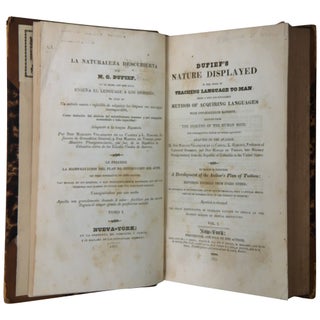A Mexican American's Guide to the Spanish Language
Dufief's Nature Displayed in Her Mode of Teaching Language to Man; Being a new and infallible method of acquiring languages with unparallelled rapidity; deduced from the analysis of the human mind, and consequently suited to every capacity: Adapted to the Spanish
Notes: A naturalized American citizen, born in Mexico, revises a popular language instruction book for Spanish speakers and contributes an original poem, one of the first Mexican American literary publications.
Nicolas Gouin Dufief wrote a very successful guide to learning French that was first published in 1804 and went through many editions. In 1811, Lewis Hargous, a teacher of French and Spanish (later at Princeton) and Manuel de Trujillo de Torres (ca. 1764–1822), a diplomat and Spanish teacher, made an authorized adaptation of Dufief's book to Spanish. Torres, a native of Spain, emigrated to Colombia in 1778; participated in an independence uprising in 1794; and fled to the US in 1796, where he lived until his death at age 58. Following Colombian independence, Torres was appointed Minister Plenipotentiary to the US.
This is the revised second edition, published after Torres's death with a significant contribution from the New York Spanish teacher, Mariano Velázquez. The introduction, perhaps written by Dufief, credits Velázquez "for the perfection which the work has obtained" and it describes him as "the Principal of an extensive Seminary, where the natives of Spanish America receive a complete education." Velázquez (1778–1860) was born in Mexico and emigrated in the early 19th century to New York, where he lived the rest of his life as an American citizen. He published many books on language and a Spanish-English Dictionary that bore his surname and remained in print for 150 years.
Velázquez was the first and the most prolific Mexican American writer of the 19th century. On the first page of the Spanish readings section (Lector español) in volume II, Velázquez contributes an original poem, one of the first to be published by a Mexican American. To date, Velázquez has received very little critical attention in the United States. His contributions to the Spanish language have been reviewed by Spanish academics. See for example, Maria del Mar Vilar García's El español, segunda lengua en los Estado Unidos (Universidad de Murcia, 2008, third edition). She concludes that Velázquez was one of the great pillars of Spanish teaching in the US during the 19th century [unos de los "grandes pilares de la enseñanza del español en los Estados Unidos durante el siglo XIX" (p. 350)]. Cecilio Garriga Escribano and Raquel Gállego Paz, at the Universitat Autònoma de Barcelona, consider his dictionary in their paper, "Velázquez de la Cadena y la lexicografía bilingüe inglés / español" (2008). Rafael Nevado Gómez explores another of his books in "Mariano Velázquez de la Cadena (1778–1860) y la adaptación del Manual Ollendorff para la enseñanza de lenguas extranjeras" (Boletín de la Sociedad Española de Historiografía, 2017).
For more on Torres and his connection to Latin American independence movements, see Raúl Coronado's A World Not to Come, pp. 152ff.
Two volumes: [iii], xlvi, [viii], 413, 78 pages; [xi], [2], 243, 310 pages. Each volume offers instruction in the Spanish language written in English followed by a separately paginated selection of readings in Spanish.
With a second title page, in Spanish: La naturaleza descubierta por N. G. Dufief, en el modo con que ella enseña el lenguage a los hombres... Nueva-York: En la Imprenta de Tompkins & Floyd, 1825.
Edition + Condition: First edition (first printing). A pleasant set, bound in the late 19th century in brown pebbled morocco and decorated paper-covered boards. Previous owner's name and bookplate on preliminaries.
Publication: New-York: Printed for, and Sold by the Authors, 1825.
Item No: #35564
Price: $1,250


